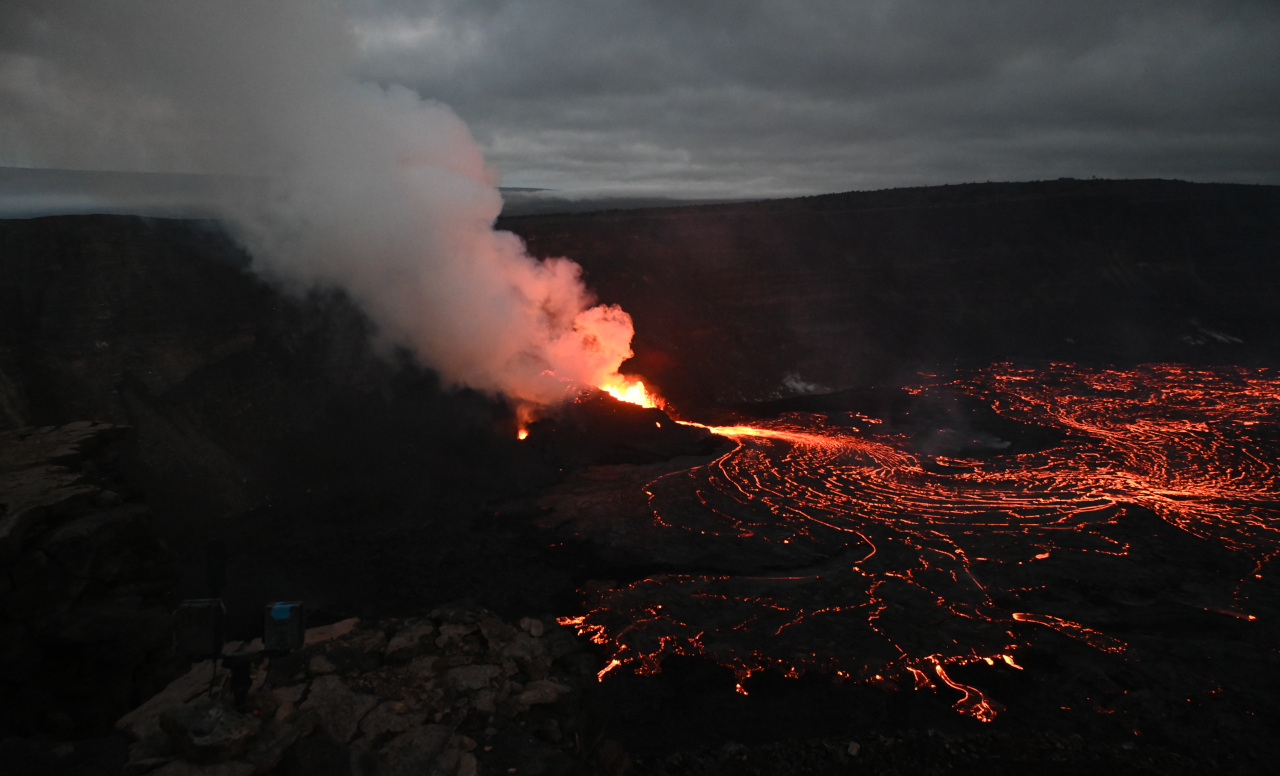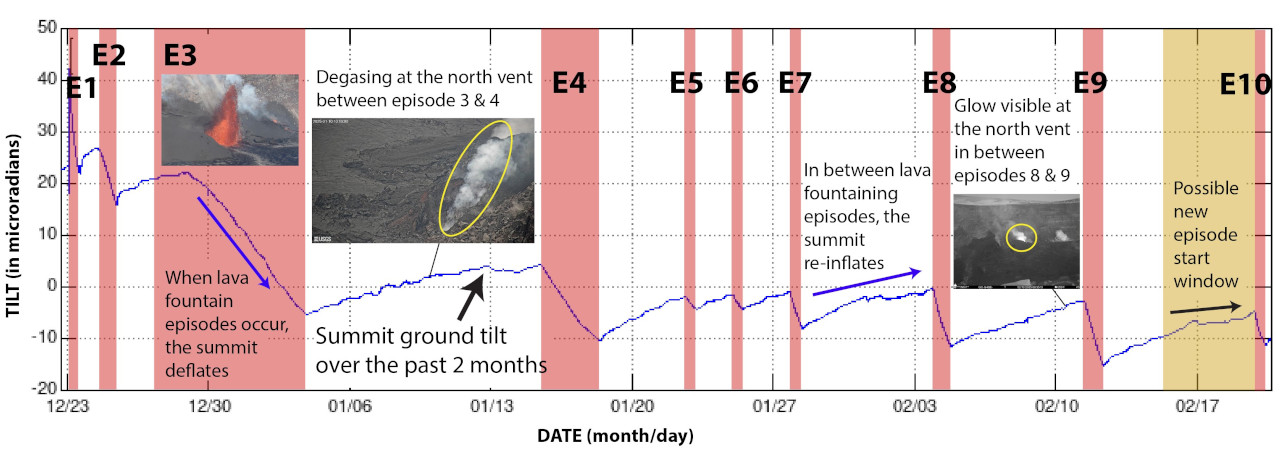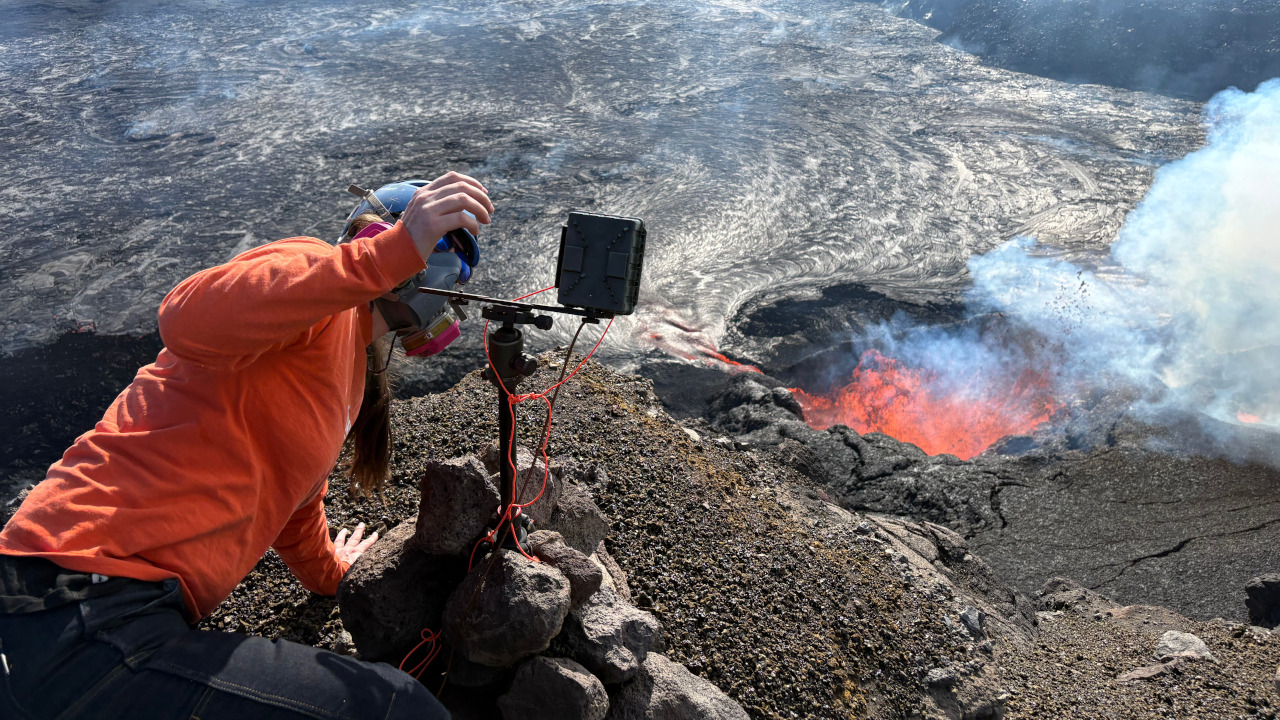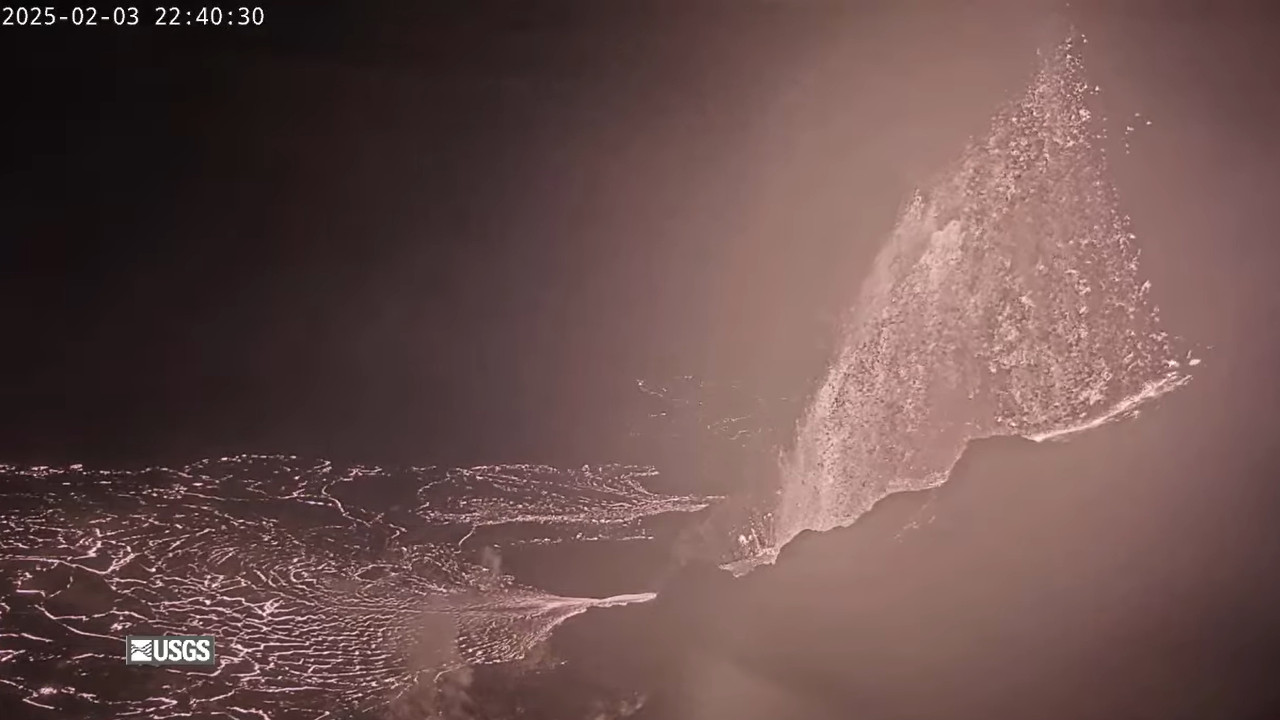
USGS: “An overview of episode 10 of the ongoing Halemaʻumaʻu eruption the morning of February 20, 2025. Episode 10 ended later that morning at 9:18 a.m HST, after just under 13 hours of fountaining. This photo shows lava fountains within the north vent feeding lava flows which covered an estimated 75% of the floor of Halemaʻumaʻu within the southern part of Kaluapele (Kīlauea caldera).” (USGS photo by L. Gallant)
(BIVN) – The ongoing Kīlauea summit eruption within Hawaiʻi Volcanoes National Park remains paused.
Scientists with the USGS Hawaiian Volcano Observatory report “preliminary estimates suggest a new eruptive episode may begin as early as Sunday, February 23”. The USGS Volcano Alert Level for Kīlauea remains at WATCH.
From this week’s Volcano Watch article written by USGS HVO scientists and affiliates:
Kīlauea has been erupting episodically for the past two months in Halemaʻumaʻu, nested within the south end of Kaluapele, the summit caldera. Captivating lava fountains burst from the vent(s) during each eruption episode. Fascinating as those episodes are, scientists at the USGS Hawaiian Volcano Observatory (HVO) are equally as interested in what’s happening beneath the surface between episodes.
Ten lava fountaining episodes have taken place in Halemaʻumaʻu since December 23, 2024, from two vents: the north vent and the south vent. Most fountaining episodes have been active for less than a day (16 hours on average), though a couple were longer duration (up to 8 days).

USGS: “Ground tilt and eruptive episodes associated with Kīlauea summit eruption December 23, 2024, until February 20, 2025. The ten eruptive episodes in Halemaʻumaʻu are highlighted in red.”
HVO staff rely on several key monitoring datasets to track the status of Kīlauea using a network of instruments across the volcano. A variety of seismoacoustic instruments record earthquakes and other ground vibrations, as well as low-frequency sound. Gas sensors sniff the volcanic gas emissions in areas downwind. Webcams, including the livestream camera, provide near real-time visual and thermal views. Ground deformation is documented using GPS units and tiltmeters. Together, these datasets can be used by scientists to analyze the processes occurring within Kīlauea.
In between each lava fountaining episode, monitoring datasets, like tilt, seismicity, and gas emissions, have shown similar behaviors. This repeating nature of activity has allowed HVO scientists to identify patterns that can be used to estimate windows of probability for future eruptive episodes in Halemaʻumaʻu.
When lava fountains are erupting in Halemaʻumaʻu, ground deformation instruments—tiltmeters, in particular—show deflation as magma that was stored in the volcano is erupted on the surface. In between lava fountaining episodes, those sensors show inflation as magma again accumulates beneath the surface and repressurizes the magma chambers. The amount of repressurization required for a new episode to start has ranged from 2–10 microradians, taking anywhere from a day to nearly two weeks. This range of repressurization is what informs HVO’s probability estimates for when a new episode most likely will begin. The rate of inflation can vary, though, which causes the probability window for the start of the next episode to be shifted in time.
While deformation shows us how magma is behaving underground between episodes, we also have data telling us that surface activity continues even while fountaining is paused. During episodes of lava fountaining, the rumblings of magma making its way out of the conduit produce an intense tremor signal seen on seismic stations across Kīlauea. The tremor rumbles at lower frequencies, caused by rapid expansion and contraction of magma within the vents. These continuous vibrations result from the formation and release of gas bubbles that drive the fountains high into the air.
Yet even between eruptive episodes, tremor has remained present. The intensity drops significantly between episodes but continues to exist until the next episode. This indicates that gas is continuing to be released by the vents and magma continues to stir near surface even when lava is not visibly erupting. As the weak tremor churns in the background, other seismic signals are also observable. Low frequency signals that range in size are seen on the seismic network around the summit area and suggest complex patterns of magma migration, bubble formation, and transport within the volcano.
The observation of continuing tremor between episodes is corroborated by volcanic gas measurements and persisting glow at the vents. When an episode of lava fountaining is occurring, sulfur dioxide (SO2) emission rates are highly elevated, in the range of 10,000 tonnes per day (t/d). Even when lava is not actively fountaining, SO2 emission rates have remained moderately elevated, in the range of 1,000 t/d. If Kīlauea were truly quiet, we would expect only about 100 t/d of SO2. Likewise, in between eruptive episodes, glow remains visible at night at the north, and sometimes south, vent. This incandescence is another clue that magma is just beneath the surface, continuing to gurgle, glow, and degas.
New episodes of lava fountaining have been brief and impressive, but the build up to them is an exciting glimpse into how Kīlauea volcano works. If you happen to visit Kīlauea in between Halemaʻumaʻu lava fountaining episodes, know that the degassing and glow are evidence of the continuous activity that is happening, hidden just beneath the surface.



by Big Island Video News7:08 am
on at
STORY SUMMARY
HAWAIʻI VOLCANOES NATIONAL PARK - Scientists with the Hawaiian Volcano Observatory say what happens beneath the Kīlauea surface doesn't always stay beneath the surface.